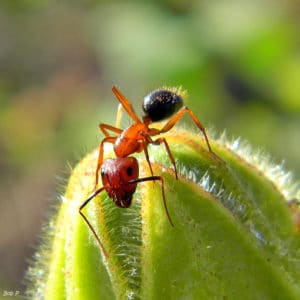To understand the epigenetic regulation of brain function and behavior, scientists are turning to ants. To understand the ants, they are applying the accurate, long reads of SMRT Sequencing.
While the genetic code of many types of ant have been combed through thanks to several genomes assembled through whole-genome shotgun sequencing, there have only been brief glimpses and guesses regarding gene regulation. Existing assemblies are highly fragmented drafts, making epigenetic studies nearly impossible.
 Eager to determine the epigenetic changes responsible for phenotypic and behavioral plasticity in Camponotus floridanus and Harpegnathos saltator ant species, a team of researchers from the Epigenetics Institute of the University of Pennsylvania’s Perelman School of Medicine used SMRT Sequencing to de novo assemble the two genomes, which had been previously sequenced using short reads.
Eager to determine the epigenetic changes responsible for phenotypic and behavioral plasticity in Camponotus floridanus and Harpegnathos saltator ant species, a team of researchers from the Epigenetics Institute of the University of Pennsylvania’s Perelman School of Medicine used SMRT Sequencing to de novo assemble the two genomes, which had been previously sequenced using short reads.
Improved genome continuity led to comprehensive annotations of both protein-coding and non-coding RNAs, and answered some questions about the differential gene expression that allows some worker ants to become acting queens in their colonies.
In a paper published in Cell Reports, first author Emily J. Shields, lead author Roberto Bonasio and their collaborators described how they solved some mechanistic mysteries through PacBio long-read sequencing.
Harpegnathos worker ants are characterized by their unique reproductive and brain plasticity that, in the absence of a queen, allows some of them to transition to a queen-like phenotypic status called “gamergate,” which is accompanied by major changes in brain gene expression.
Previous work by the group in Harpegnathos and in the more conventional Florida carpenter ant Camponotus floridanus had suggested that epigenetic pathways, including those that control histone modifications and DNA methylation, might be responsible for differential deployment of caste-specific traits; pharmacological and molecular manipulation of histone acetylation has been shown to affect caste-specific behavior in Camponotus ants, suggesting a direct role for epigenetics in their social behavior.
“Although the molecular mechanisms by which environmental and developmental cues are converted into epigenetic information on chromatin remain subject of intense investigation, it has become clear that non-coding RNAs play an important role in mediating this flow of information,” the authors write.
In particular, they were interested in long non-coding RNAs (lncRNAs), which are transcripts longer than 200 base pairs that are not translated into proteins. Annotated extensively in human, mouse, bees, zebrafish, Drosophila melanogaster and Caenorhabditis elegans, no comprehensive annotation of lncRNAs in ants has been reported, limiting the reach of ant species as model organisms.
As many cis regulatory and epigenomic mechanisms take place at short-to-medium range (10–100 kb), the scientists wanted to span large repetitive regions and create longer gap-free regions of sequence (i.e., longer contigs) than those produced by previous short-read assemblies, so they turned to PacBio.
“Long PacBio reads allowed us to assemble across longer repeats than previously possible, greatly improving the contiguity of the Harpegnathos and Camponotus genomes,” the authors write.
They sequenced genomic DNA isolated from Harpegnathos and Camponotus workers using SMRT Sequencing, obtaining a sequence coverage of 70-fold for Harpegnathos and 53-fold for Camponotus, with longer contigs (on average more than 30-fold larger than a prior 2010 assembly) and scaffolds with fewer gaps. The assemblies have scaffold N50 sizes larger than 1 Mb, and gaps smaller than in all other insect genomes available on NCBI at the time of writing.
The UPenn team annotated protein-coding genes using a combination of methods, and they discovered more than 300 high-confidence lncRNAs, several of which displayed developmental-, brain-, or caste-specific expression patterns, suggesting important roles in development and brain function.
They were also able to identify some biologically relevant genes missing in the older versions of the genome assemblies. Most notably, a Gp-9-like gene previously unannotated in the Harpegnathos genome was found to be differentially expressed in worker brains compared to gamergates. Mass spectrometry analyses identified two peptides mapping exactly to the newly predicted sequence, confirming the accuracy of the updated gene model.
“This gene was not previously detected as differentially expressed, likely because its closest homolog in the old annotation contains many sequence disparities, reducing the RNA-seq coverage mapped to this gene in both castes,” the authors write.
The UPenn team will use the new assemblies to direct their future explorations of neuroepigenetics in ants. They also hope the work will have a wider impact on the field.
“Our greatly improved Harpegnathos and Camponotus assemblies deliver several critical benefits to further development of these ant species into molecular model organisms,” the authors conclude. “These improvements… will lead to greater understanding of the genetic and epigenetic factors that underlie the behavior of these social insects.”
July 17, 2018 | Plant + animal biology